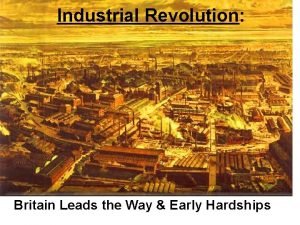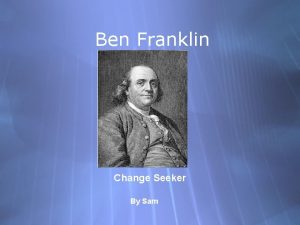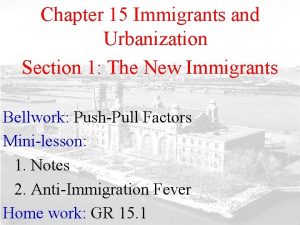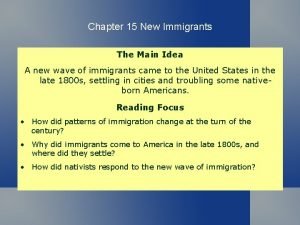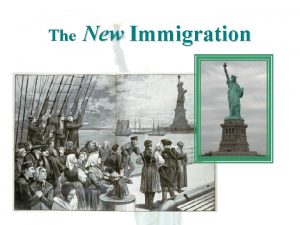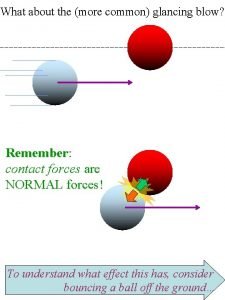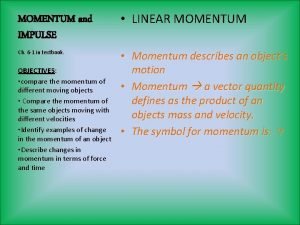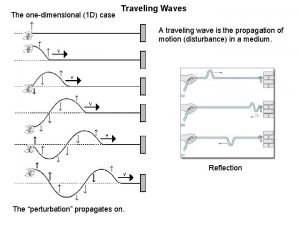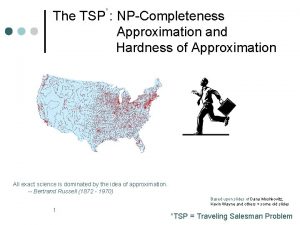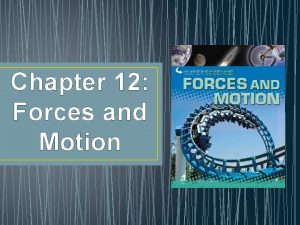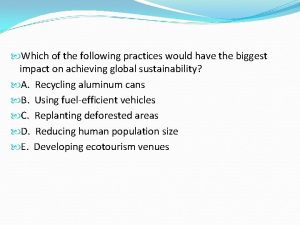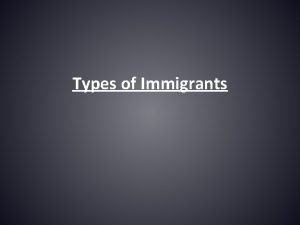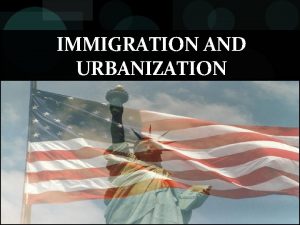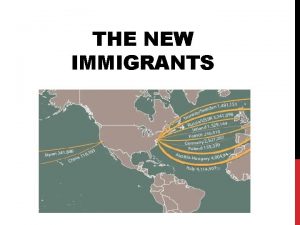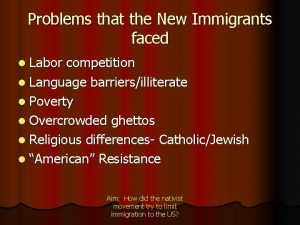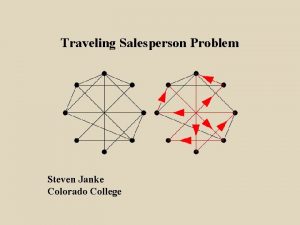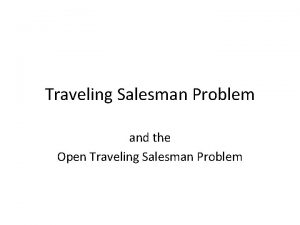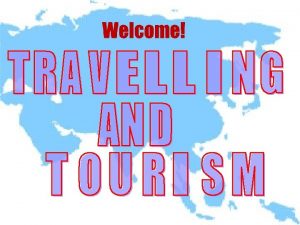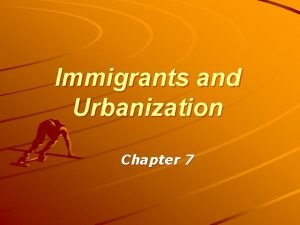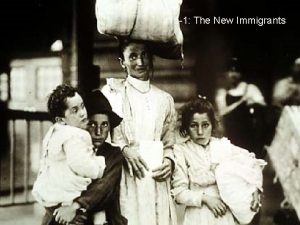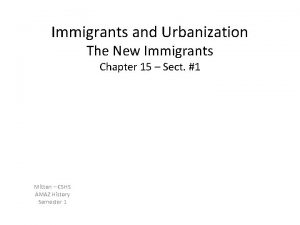The New Immigrants Hardships Immigrants Faced Traveling in
































- Slides: 32

The New Immigrants Hardships Immigrants Faced • Traveling in steerage • Getting examined at the port of entry • Learning a new language and a new culture • Facing the prejudice of “Nativists”

Background knowledge n The industrial age changed the face of cities with new buildings and bridges. ¡ It also changed the population. n Millions arrived each year to the U. S. in search of work and a better life. • A growing network of railroads. • New inventions and the assembly line. • Abundance of natural resources • Land grants and subsidies offered by the government

A Fresh Start n Between 1865 and 1915, some 25 million immigrants entered the Untied States. ¡ This was more than the population of the entire country in 1850!

PUSH/PULL THEORY PULL (+) PUSH (-) 1. 2. 3. 4. 5. 6. 7. Religious persecution Political persecution Revolution/war No jobs (no work) No land Drought (no rain=no food) Poverty (no money) 1. 2. 3. 4. 5. 6. 7. 8. 9. Religious freedom Political Freedom Friends/family Jobs Land Fertile Land Greater wealth Safer atmosphere Education

• Colonial • Old • New • Modern “Old Immigrants” arrived before 1880. ---------“New Immigrants” arrived after 1880


Old Immigrants n During the period of “Old Immigration, ” which started in the 1830 s and reached a high point in the 1840 s, waves of immigrants arrived from northern and western Europe. ¡ ¡ ¡ ¡ England Ireland Germany Holland Sweden France Scotland

The new immigrants n The wave of “new immigrants” in the late 1800 s came from southern and eastern Europe, as well as from Asia and the Pacific. ¡ Southern and eastern Europe: Italy, Poland, Russia, and Greece. DEMOCRACY a form of government in which all eligible citizens have an equal say in the decisions that affect their lives Few new immigrants understood English or had experience living in a democracy or a city.

Modern 1940 -2016 New 1880 -1930 s Old 1800 -1870 s Colonial 1500 -1790 s



Starting a new life n The decision to emigrate is a difficult one. ¡ n It meant leaving home, family, and friends and starting a strange life. The passage to America was miserable. ¡ Most immigrants came to the United States crammed into the steerage of ships. n Steerage consisted of large compartments that usually held cattle.

STATUE OF LIBERTY Have you been here?

Ellis island n Most people coming from Europe landed in New York. ¡ ¡ ¡ After 1892, most people went through the receiving center on Ellis Island in New York. After receiving hundreds of thousands of immigrants to the U. S. since its establishment as a processing station in 1892, Ellis Island was closed in 1954. Due to its importance to U. S. history, it was included as part of the Statue of Liberty National Monument in 1965.

Angel island n Asian Immigrants entered through Angel Island in San Francisco, California .


Did you pass the test? n n New arrivals faced a rigorous physical examination at the receiving centers. ¡ Did they limp? ¡ Were their eyes free of disease? Those judged to be disabled or seriously ill might be sent home.

Ethnic neighborhoods n About two thirds of immigrants settled in cities. ¡ WHY? ? ? n That’s where the work was (Industry). n Many immigrants settled near other people from the same country in ethnic background. ¡ Here, they could speak their native language and observe familiar holidays.

Becoming american n In what ways are they holding onto tradition? Many newcomers to America clung to their traditional ways while trying to assimilate. ¡ Assimilation is the process of becoming part of another culture. n Surrounded by English-speakers at school, children of immigrants learned the language more quickly and were more easily assimilated. Yay!! I can’t wait for Mrs. Dolan’s class

IMMIGRATION THEORIES Sociologists have identified a few major theories on how newly arrived immigrants integrate themselves into American society. Over time all new immigrants adopt some aspects of American culture and add something new. Wok theory? ? ? Salad Bowl Theory According to the Salad Bowl Theory there are times when newly arrived immigrants do not lose the unique aspects of their cultures like in the melting pot model, instead they retain them. The unique characteristics of each culture are still identifiable within the larger American society, much like the ingredients in a salad are still identifiable, yet contribute to the overall make up of the salad bowl. It is theory that also accounts for the retention of the "something-American" hyphenation when identifying cultural identity. This theory is also referred to as pluralism. Melting Pot Theory According to the Melting Pot Theory peoples from various cultures come to America and contribute aspects of their culture to create a new, unique American culture. The result is that contributions from many cultures are indistinguishable from one another and are effectively "melted" together


Immigrant labor n Immigrant labor was essential to the new economy. ¡ ¡ Desperate for money, newcomers took whatever jobs they could find. Immigrants worked in steel mills, meat-packing plants, and garment factories. n They helped build skyscrapers, railroads, subways, and bridges. n With hard work and saving, immigrants slowly advanced economically. What bridge is this?

Some notable immigrants n Alexander Graham Bell: Scotland (invented the telephone). n Andrew Carnegie: Scotland (steel magnate; donated money to charities). n Samuel Goldwyn & Louis Mayer: Eastern Europe (helped establish the motion picture industry in California).

A new wave of nativism n As immigration increased, a new wave of nativists sought to preserve the country for native-born Americans. ¡ ¡ They’re taking OUR jobs!! The new immigrants are too different. Look at their clothing and try and listen to them speak. They will never be able to assimilate. NATIVIST Nativists charged that foreigners would never assimilate and also that they took jobs from Americans. Many Americans associated immigrants with anarchy, crime, and violence. n An anarchist is a person who opposes all forms of government.

NATIVISM


No chinese allowed!!! n In the West, nativist feelings against Chinese drove many Chinese immigrants from mining camps and cities. ¡ The Chinese Exclusion Act of 1882 excluded, or kept out, Chinese laborers from the United States until it was repealed in 1943. n In 1917, Congress passed a law that barred those who could not read their own language from immigrating to the United States. n Emergency Quota Act of 1921 and the Immigration Act of 1924 both limited the number of immigrants trying to enter the U. S. ¡ Preference was given to English speaking countries whose governments were similar to the U. S. n Example: Great Britain


Why did immigration to the United States greatly increase between 1900 -1910? What is a QUOTA?


• What are the two men talking about? • When the man refers to the “green man”, who is he talking about?

copyrigh Violence and drinking
 Old immigrants vs new immigrants
Old immigrants vs new immigrants Hardships of early industrial life
Hardships of early industrial life Frida kahlo hardships
Frida kahlo hardships Acts 14 22
Acts 14 22 Hardships of early industrial life
Hardships of early industrial life Tokogawa
Tokogawa Benjamin franklin hardships
Benjamin franklin hardships Traveling might satisfy your desire for new experiences.
Traveling might satisfy your desire for new experiences. Gerunde
Gerunde Traveling might satisfy your desire for new experiences
Traveling might satisfy your desire for new experiences Traveling might satisfy your desire for new experiences.
Traveling might satisfy your desire for new experiences. Chapter 15 immigrants and urbanization
Chapter 15 immigrants and urbanization New wave immigrants
New wave immigrants Chapter 15 section 1 the new immigrants
Chapter 15 section 1 the new immigrants The new immigrants
The new immigrants A car traveling at 100 km/h strikes an unfortunate bug
A car traveling at 100 km/h strikes an unfortunate bug Travel requisition
Travel requisition Traveling guideline hair cutting
Traveling guideline hair cutting What is popular nowadays
What is popular nowadays A railroad flatcar is traveling to the right at a speed of
A railroad flatcar is traveling to the right at a speed of Linear momentum and impulse
Linear momentum and impulse Even swap method
Even swap method Traveling salesman problem beispiel
Traveling salesman problem beispiel Traveling mattes
Traveling mattes Traveling wave
Traveling wave Tsp np hard
Tsp np hard Which universal force can repel as well as attract?
Which universal force can repel as well as attract? Traveling salesman problem erklärung
Traveling salesman problem erklärung A 2200 kg vehicle traveling at 94 km/h
A 2200 kg vehicle traveling at 94 km/h Traveling tournament problem
Traveling tournament problem Binay bhattacharya
Binay bhattacharya Which of the following
Which of the following Hatchet chapter 10
Hatchet chapter 10




